Unit - 1
Mode of Transportation
1.1 Modes of Transportation

Fig: Modes of transportation
- Road transport
| Advantages |
| Disadvantages |
1. | Less Capital Outlay | 1. | Seasonal Nature |
2. | Door to Door Service | 2. | Accidents and Breakdowns |
3. | Service in Rural Areas | 3. | Unsuitable for Long Distance and Bulky |
4. | Flexible Service | Traffic | |
5. | Suitable for Short Distance | 4. | Slow Speed |
6. | Lesser Risk of Damage in Transit | 5. Lack of Organization | |
7. | Saving in Packing Cost |
|
|
8. | Rapid Speed |
|
|
9. | Less Cost |
|
|
2. Railway transport
| Advantages |
| Disadvantages |
1. | Dependable | 1. | Huge Capital Outlay |
2. | Better Organized | 2. | Lack of Flexibility |
3. | High Speed over Long Distances | 3. | Lack of Door-to-Door Service |
4. | Suitable for Bulky and Heavy Goods | 4. | Monopoly |
5. | Cheaper Transport | 5. | Unsuitable for Short Distance and Small |
6. | Safety | Loads | |
7. Larger Capacity | 6. | Booking Formalities | |
8. | Public Welfare | 7. | No Rural Service |
9. | Administrative Facilities of Government | 8. | Under-utilized Capacity |
10. Employment Opportunities | 9. | Centralized Administration | |
3. Air transport
| Advantages |
| Disadvantages |
1. | High Speed | 1. | Very Costly |
2. | Comfortable and Quick Services | 2. | Small Carrying Capacity |
3. | No Investment in Construction of Track | 3. | Uncertain and Unreliable |
4. | No Physical Barriers | 4. | Breakdowns and Accidents |
5. | Easy Access | 5. | Large Investment |
6. | Emergency Services | 6. | Specialized Skill |
7. | Quick Clearance | 7. | Unsuitable for Cheap and Bulky Goods |
8. | Most Suitable for Carrying Light Goods of | 8. | Legal Restrictions |
High Value |
|
| |
9. | National Defense |
|
|
10. Space Exploration |
|
| |
Key takeaway:
Modes of transport:
- The different modes of transport are air, water, and land transport, which include Rails or railways, road and off-road transport.
- Other modes also exist, including pipelines, cable transport, and space transport.
- They facilitate conveyance of people, goods, raw-materials, manufactured articles, etc. speedily and easily in the different parts of a country.
- They act as the only source of communication in regions of high altitude i.e., in mountainous regions.
- They help in growth of trade and other economy activities in and outside the villages and towns by establishing contact between towns and villages.
- They help in providing efficient distribution of agricultural products and natural resources all over the country.
- They help in price stabilization of commodities due to mobility of products all over the country.
- They help in social and cultural advancement of people and making the villagers active and alert members of the community.
- They help in promoting the cultural and social ties among people living in different part of a country and thus strengthen the national unity.
- They help in providing improved medical facilities quickly to human beings, especially to those who live in rural areas.
- They provide more employment opportunities.
- They enhance land value and thus bring better revenue.
- They serve as feeders for Airways, Waterways and Railways.
- They help in reducing distress among the people, caused due to famine, by supplying them food and clothing quickly.
- British government passed a resolution in 1927, in response to which Jayakar Committee was constituted in 1927.
- Jayakar Committee proposed an extra tax on diesel and petrol (Rs. 2/liter) to develop a fund known as ‘Central Road Fund’ in 1929. 0.50 paise was kept by the Central Government for construction and maintenance of National Highways and Rs. 1.50 was distributed among State Governments to develop State Highways, Village Roads, and other District Roads etc.
- On the recommendations of the Jayakar Committee, a semi-official technical body by the name of ‘Indian Roads Congress’ (IRC) was formed in 1934 to pool technical know-how from various parts of the country and to act as an advisory body on various aspects of road development.
- Furthermore, in 1950, Jayakar Committee initiated the formation of Central Road Research Institute (CRRI), a research organization to carry out the research and development work.
- Few other important landmarks:
- Motor Vehicle Act – 1939
- National Highway Act – 1956
- Highway Research Board – 1973
- National Transport Policy Committee – 1978
6. IRC played an important role in the formation of the three 20-year road development plans in India:
- First 20-years Road Plan: 1943 - 1963
- Second 20-years Road Plan: 1961 - 1981
- Third 20-years Road Plan: 1981 - 2001
20-years Road Development Plans
Parameters | First 20-year Road Plan | Second 20-year Road Plan | Third 20-year Road Plan |
Name | Nagpur | Bombay | Lucknow |
Duration | 1943-1963 | 1961-1981 | 1981-2001 |
Target Density | 16 km/ 100 km2 | 32 km/ 100 km2 | 82 km/ 100 km2 |
Road Pattern | Star & Grid | ----- | Square Grid |
Planned Expressway Length | ---- | 1600 km | 2000 km |
Development Allowance | 15% | 5% | --- |
Classification of Roads | NH/ SH/ MDR/ ODR/ VR | ----- | Primary: Expressway/ NH Secondary: SH/ MDR Tertiary: ODR/ VR |
Key takeaway:
IRC (Indian Road congress):
- The Indian Roads Congress (IRC) is the Apex Body of Highway Engineers in the country.
- The IRC was set up in December, 1934 on the recommendations of the Indian Road Development Committee best known as Jayakar Committee set up by the Govt. Of India with the objective of Road Development in India.
1. Principle of highway planning:
(i) Planning a highway network for safe, efficient and fast movement of people and goods.
(ii) Keeping the overall cost of construction and maintenance of the roads in the network to a minimum.
(iii) Planning for future development and anticipated traffic needs for a specific design period.
(iv) Phasing road development programmes from considerations of utility and importance as also of financial resources.
2. Road development plans:
- Nagpur Road Plan
The Second World War saw a rapid growth in road traffic and this led to the deterioration in the condition of roads.
To discuss about improving the condition of roads, the government convened a conference of chief engineers of provinces at Nagpur in 1943. The result of the conference is famous as the Nagpur plan.
A twenty-year development programmed for the period (1943-1963) was finalized. It was the first attempt to prepare a co-ordinate road development programmed in a planned manner.
The roads were divided into five classes:
- National highways which would pass through states, and places having national importance for strategic, administrative and other purposes.
- State highways which would be the other main roads of a state.
- District roads which would take traffic from the main roads to the interior of the district. According to the importance, some are considered as major district roads and the remaining as other district roads.
- Village roads which would link the villages to the road system.
- The committee planned to construct 2 lakh kms of road across the country within 20 years.
- One of the objectives was that the road length should be increased so as to give a road density of 16kms per100 sq.km.
- Bombay Road plan & 3rd20-Year Road Plan
Bombay Road Plan
The length of roads was under the Nagpur plan was achieved by the end of it, but the road system was deficient in many respects.
Accordingly, a 20-year plan was drafted by the roads wing of government of India, which is popularly known as the Bombay plan.
The highlight of the plan was:
It was the second-year road plan 1961 to 1981.
The total road length targeted to construct was about 10 lakhs.
Rural roads were given specific attention.
They suggested that the length of the rod should be increased so as to give a road density of 32 km per hundred square kilometers.
The construction of 1600 km of expressways was also then included in the plan.
- 3rd 20-Year Road Plan (Luck now)
This plan has been prepared keeping in view the growth pattern envisaged in various held by the turn of the century. Some of the salient features of this plan are as given below:
This was the third 20-year road plan (1981-2001). It is also called Luck now road plan.
It aimed at constructing a road length of 12 lakh kilometers by the year 1981 resulting in a road density of 82kms/100 sq.km.
The plan has set the target length of NH to be completed by the end of seventh, eighth and ninth five-year plan periods.
It aims at improving the transportation facilities in villages, towns etc. such that no part of country is farther than 50 km from NH.
One of the goals contained in the plan was that expressways should be constructed on major traffic corridors to provide speedy travel.
Energy conservation, environmental quality of roads and road safety measures were also given due importance in this plan.
3. Highway alignments requirements:
1. Short
The alignment should be short so as to make the road project economical. To meet this requirement, the alignment should be as straight as possible.
2. Easy
The alignment should be such that it is easy to construct and maintain the road with minimum problems.
3. Safe
The alignment should be safe for traffic operation. It should be safe for the construction and maintenance of the road.
4. Economical
The alignment should be economical in its cost of construction, maintenance and traffic operations.
5. Utility
The alignment should be such that it would offer maximum utility by serving maximum population and products.
6. Natural Aspects
The alignment should have good natural aspect.
4. Engineering Surveys for Highway Alignment:
The following steps are involved in finalizing the Highway alignment& preparing the project:
- Map Study:
It is the very first step of highway survey.
In this, we use a topographic map of the area under consideration, which can be availed from the Survey of India. Using the map, we can propose different alternatives of the road alignment.
The topographic map usually has contour intervals of around 30 m to 40 m.
We can get the details of the natural as well as man-made land features of the area using this map, and based on this we can then suggest a number of options for the road alignment.
These alternative route options are further studied in detail in the later steps.
- Reconnaissance Survey:
This is done to examine the general character of the area for deciding the most feasible routes for detailed studies.
Basic surveying instruments are used in the reconnaissance survey.
Following data is obtained from Reconnaissance Survey:
- Valley, pond, lakes and other features that may not be present on the topographical map.
- A number of cross drainage structures, High Flood Level (HFL), Natural Ground Level etc.
- Values of the gradient, the length of gradients and radius of the circular curve.
- Soil type along the routes from field identification tests and observation of the geological features.
- Sources of construction materials.
- Preliminary Survey:
This is carried out to collect all the physical information which is necessary in connection with the proposed highway alignment. This work consists of:
- Primary traverse survey
- Study of topographical features
- Leveling work
- Drainage studies & hydrological data
- Soil survey
- Material survey
- Determination of final center line
This may be done using:
- Conventional Approach: This includes using conventional survey instruments.
- Modern Rapid Approach: This is done by aerial photography.
5. Engineering surveys for highway location:
Location of the highway alignment is done after carrying out a survey of the area. These surveys are called Engineering Surveys.
We have to locate an alignment which fulfils the basic requirements like the path must be short, safe, economic, easy and useful.
Engineering Surveys in the following phases:
- Map Study
- Reconnaissance Surveys
- Preliminary Surveys
- Location Surveys
1) Map Study
This is the first step of the Engineering survey, using a topographic map of the area under consideration, which can be availed from the Survey of India.
This topographic map, in general, has a contour interval of around 30 m to 40 m.
2) Reconnaissance Survey
So, in the second phase/step a survey team is headed to the area under study with the minor surveying instruments like Abney level, Tangent Clinometers etc. to do a rough survey of the area under study.
The rough survey is done along the alternatives proposed in the map study and feasibility of the road alignment is checked along the different routes.
Some of the routes may be cancelled out or they may be changed if they appear to be impossible in this study. So finally, they will have a set of routes which are to be further studies in the next step.
3) Preliminary Survey
In this step, the alternative routes which are proposed after a rough survey in the second step are surveyed in details using some advanced instruments like levels, chain and theodolite. Aerial Photogrammetric is best suited for this type of survey.
All the necessary details to carry out the comparative study of the different routes are collected and then finally we have to decide one alignment best suited for the alignment of the road.
Here various details are found out along the stretches of the routes, which can also be found using the aerial techniques by taking photographs along the routes and then further processed to find out the final details of the area.
4) Location Survey
Location of the centerline of the road is done with very much precise instrument like Theodolite and Chain using the drawing prepared or the details gathered in the third step (i.e., Preliminary survey).
This is done by staking the ground with the stakes inserted at the intervals of 50 m to 100 m in the plain area, 50 m to 75 m in the rolling terrain and 30 m to 50 m in the hills and steep terrain.
Pegs may be driven at all the control points. At the curves control points, starting of the transition curve, starting off the circular curve and terminal of the circular curve and the terminal of the transition curve the pegs/stakes are driven into the ground to firmly locate these control points. Benchmarks are located at an interval of 250 m and they are necessarily located at the sites of the cross drainage works.
5) Detailed Survey
In this part, we have carried out the detailed study of the final route using some very precise instruments like Theodolite and Chain to gather all the necessary data for the final estimation, design and preparing drawings using which the construction can be started.
A detailed project report is to be prepared and all the necessary data is collected to prepare that report.
So, the profiling, cross-sectioning and soil investigation are carried out very precisely. CBR values are also found to find out the design thickness of the pavement. After collecting the data, a final drawing, a report is prepared which concludes the highway planning part.
Key takeaway:
- Location of the centerline of the road is done with very much precise instrument like Theodolite and Chain using the drawing prepared or the details gathered in the third step
- A detailed project report is to be prepared and all the necessary data is collected to prepare that report.
- After collecting the data, a final drawing, a report is prepared which concludes the highway planning part.
- State highways which would be the other main roads of a state.
- District roads which would take traffic from the main roads to the interior of the district.
6. Energy conservation is the effort made to reduce the consumption of energy by using less of an energy service.
7. This can be achieved either by using energy more efficiently (using less energy for a constant service) or by reducing the amount of service used (for example, by driving less).
1. Geometric design- Design controls
The geometric design of highways is that stage of highway design which deals with the dimensions of the road and layout of visible features of the highway. It is majorly concerned with the design of the road elements and does not include pavement design, structural and drainage components. The geometrics of highway should be designed to provide optimum efficiency in traffic with maximum safety at the reasonable cost. The design of such features is highly influenced by traffic, driver behavior and psychology and vehicle characteristics.
2. Highway cross-sectional elements
The features of the cross-section of the pavement influence the life of the pavement as well as the riding comfort and safety.
- Carriageway
- Shoulder
- Roadway Width
- Right of Way
- Building Line & Control Line
- Median
- Camber
- Side Slope
- Lateral and Vertical Clearances
- Kerb
- Guard Rail
- Side Drain
- Other Facilities
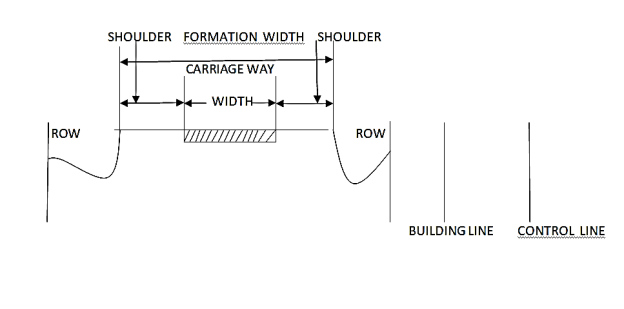
Fig.: Cross-section of Roads

- Friction
Friction determines the operating speed and distance requirements in stopping & accelerating the vehicles.
Skidding occurs in a vehicle when transverse movement of tyre > circumferential movement of tyre.
Slipping occurs when circumferential movement of tyre > transverse movement of tyre.
Factors affecting friction are:
a) Type & condition of pavement surface
b) Type & condition of tyre & tyre-pressure
c) Speed of vehicles
d) Temperature of tyre& pavement
Coefficient of friction decreases with increase in temperature, load & tyre pressure.
As per IRC,
Longitudinal friction coefficient = 0.35 to 0.40
Lateral friction coefficient = 0.15
When a longitudinal friction coefficient of 0.40 is allowed for stopping a vehicle, the resultant retardation is 3.93m/s2, which is not too uncomfortable for passengers.
b. Pavement unevenness
A Bump Integrator is used to measure vertical undulations of pavement surface recorded per unit horizontal length of the road.
- Unevenness index < 150 cm/km for good pavement surfaces of high-speed highways
- Unevenness index = 250 cm/km is satisfactory for speed up to 100 km/hr
- Unevenness index = 350 cm/km is uncomfortable to passengers even at50 km/hr.
c. Camber/ cross-slope
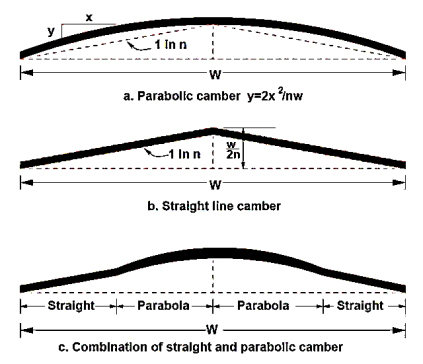
- Camber is the slope provided to the road surface in the transverse direction to drain off the rain water from the road surface.
- The requirement of camber depends upon:
- Type of pavement surface
- Amount of rainfall
- Shape of camber:
- Parabolic & elliptic – preferred by fast moving vehicles, because they require frequent crossing over the crown line during over-taking operations
- Straight line – to provide very flat cross slope in cement concrete pavements
Note: Superior the road, flatter the camber (RCC > CC > Thick BT > Thin BT > WBM > Gravel > Earth).
Types of Road Surface | Camber | |
Heavy Rainfall | Light Rainfall | |
Cement concrete & high bituminous | 2% | 1.7% |
Thin bituminous | 2.5% | 2% |
WBM & gravel pavement | 3% | 2.5% |
Earth | 4% | 3% |
d. Width of Pavement/ carriageway
Considering that IRC recommends the maximum width of a vehicle to be 2.44m, the minimum width of pavement criteria is given as follows:
- Single Lane = 3.75m
- Two Lane (without kerb) = 7.0m
- Two Lane (with kerb) = 7.5m
- Intermediate Lane = 5.5m
- Multi-lane pavement = 3.5m/lane
- Width of single lane for village roads = 3m
e. Traffic separators/ medians
As per IRC, minimum desirable width of 5m for medians of rural highways is recommended.
It may be reduced to 3m where land is restricted.
Width of median can be further reduced to 1.2 – 1.5m for long bridges.
IRC Recommendations for Median Width:
At urban intersection = 1.2m
For vehicles making right turn = 4m to 7.5m
For vehicles crossing at grade = 9m to 12m
f. Kerb height
A Kerb is the edging of a pavement (or a sidewalk) near a road. It indicates the boundary between the pavement and shoulder, or sometimes islands or footpath. The heights of different types of kerbs are:
Low-mountable = 10 cm
Semi-barrier = 15 cm
Barrier = 20 cm
1. Right of way: - A right-of-way (ROW) is a right to make a way over a piece of land, usually to and from another piece of land.
2. Roadway Width: - In particular, the width of the standard road lane in the United States is specified to be 3.7 m for the interstate highway systems, while the narrower lanes are used on lower classification roads.
3. In Europe, the road and lane width vary by country, but the minimum width of the lane is generally from 2.5 to 3.25 m.
3. Cross-slope or camber
Camber or Cant is the cross slope provided to raise the middle of the road surface in the transverse direction to drain rainwater from the road surface.
The objectives of providing the camber are
1. Surface protection (especially for gravel and bituminous roads)
2. Sub grade protection (by proper drainage)
3. Quick-drying of pavement which in turn increases safety
Depending on the type of road surface and amount of rainfall, the following camber is suggested by IRC:
Surface Type | Heavy Rain | Light Rain |
Concrete/Bituminous | 2% | 1.7% |
Gravel/WBM | 3% | 2.5% |
Earthen | 4% | 3% |
Excessive camber or cross slope should be avoided because
- Excessive camber will cause a transverse tilt of the vehicle making it uncomfortable for passengers. Also, the distribution of load to different wheels will not be uniform, leading to uneven wear and tear of wheels and damage to pavements.
- With excessive camber, heavy rain will result in the formation of heavy cross ruts.
- The central seeking tendency of vehicles will increase to avoid transverse tilt.
Different types of Camber:
Parabolic Camber
Straight Line Camber
Combination of Straight and Parabolic Camber
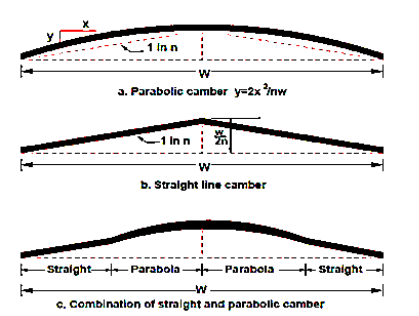
Fig: Types of camber
2. Road width:
In particular, the width of the standard road lane in the United States is specified to be 3.7 m for the interstate highway systems, while the narrower lanes are used on lower classification roads. In Europe, the road and lane width vary by country, but the minimum width of lane is generally from 2.5 to 3.25 m.
3. Road margin:
The portion of the road beyond the carriageway and on the roadway can be generally called road margins. Different elements of road margins are shoulder, parking lanes, bus bays, cycle track, footpath and guard rails.
4. Typical cross section of roads
In the cross section of roads, it is that portion of the roadway between the outer edge of the outer traffic lane and the inside edge of the ditch, gutter, curb or slope.
5. Design speed
Design speed is the target speed at which drivers are intended to travel on a street, and not, as often misused, the maximum operating speed. Actively designing for target vehicle speeds is critical to safety. Changing a street's design results in behavior changes.
6. Sight distance
The safe and efficient operation of vehicles on the road depends very much on the visibility of the road ahead of the driver.
Thus, the geometric design of the road should be done such that any obstruction on the road length could be visible to the driver from some distance ahead.
This distance is said to be the sight distance.
For straight road on level ground, there is no problem of side distance. But Straight Road on level ground is a rare case.
Horizontal curves, vertical curves (Summit), intersections are potential places where there could be a restriction in terms of Sight distance
The actual distance along the road surface over which a driver from a specified height above the carriageway has visibility of the stationary or moving object
The sight distance used for design is
Stopping Sight Distance (SSD) or absolute minimum sight distance
Intermediate Sight Distance (ISD) = 2*SSD
Overtaking Sight Distance (OSD) for safe overtaking
Headlight Sight Distance = SSD at night
Key takeaway:
1. Intermediate sight distance: -Intermediate sight distance (ISD) is defined as twice SSD. Overtaking sight distance (OSD) for safe overtaking operation. Headlight sight distance is the distance visible to a driver during night driving under the illumination of headlights.
2. Overtaking sight distance: -The overtaking sight distance is the minimum distance open to the vision of the driver of a vehicle intending to overtake the slow vehicle ahead safely against the traffic in the opposite direction.
3. Headlight sight distance: -Headlight sight distance is the distance visible to a driver during night driving under the illumination of headlights.
- Design of Horizontal alignment:
A horizontal curve acts as a transition between two tangent strips of roadway, allowing a vehicle to negotiate a turn at a gradual rate rather than a sharp cut.
The design of the horizontal curve is dependent on the design speed for the roadway, as well as the drainage conditions and friction factor for the road.
The centrifugal force developed at the curve is counter-acted by the transverse frictional resistance developed between the tyres and the pavement.
Mathematically, centrifugal force P = 
Ratio of centrifugal force P to the weight of the vehicle W is known as centrifugal ratio or impact factor.
 =
= 
The centrifugal force acting on a vehicle while negotiating a horizontal curve has two effects:
1. Overturning Effect (tendency to overturn the vehicle outwards about the outer wheels)

P.h = W x 
For no over-turning condition,
[ =
=  ] ≤
] ≤ 
2. Transverse Skidding Effect (tendency to skid the vehicle laterally outwards)
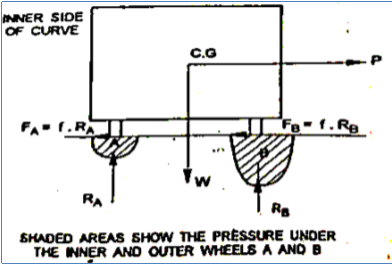
Frictional force = Fw
Centrifugal force = P = 
For no skidding condition, centrifugal force ≤ frictional force
[ =
=  ] ≤ f
] ≤ f
Super Elevation:
Super Elevation is the transverse slope to counteract the centrifugal force and to reduce the tendency of the vehicle to overturn or skid.
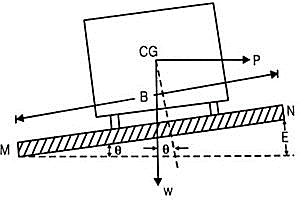
e =  = tan
= tan
Since is extremely small,
Tan ≈ sin = 
Where,
B = pavement width
E = relative elevation of outer edge
Calculation of Super Elevation:
The following forces act on vehicle while moving on a circular curve of radius R with speed V m/sec:
a) Centrifugal force P acts horizontally outwards through C.G
b) Weight of the vehicle W acts vertically downwards through C.G
c) Frictional force acts inwards towards the center of the curve

For equilibrium,
P cos = W sin + f (W cos + P sin )
P (cos - f sin ) = W sin + f. Wcos
 =
=  = e + f
= e + f
Also,
e + f =  =
=  (v is speed of vehicle in m/sec)
(v is speed of vehicle in m/sec)
We can also say, e + f =  =
=  (V is speed of vehicle in kmph)
(V is speed of vehicle in kmph)
R = radius of curve in metre
e = rate of super elevation = tan
f = design value of lateral friction = 0.15
Minimum & Maximum Value of Super Elevation (IRC Recommendations)
Maximum value of super elevation:
a) emax = 7% for plain & rolling terrain
b) emax = 10% for hilly terrain without snow
c) emax = 4% for urban roads with frequent inter-section
Minimum value of super elevation:
emin = camber from drainage consideration
Attainment of Super Elevation
Complete super elevation is attained at the end of transition curve or at the beginning of the circular curve. The attainment of super elevation can be split into two parts:
a) Elimination of the crown of the cambered section
b) Rotation of the pavement to attain full super-elevation
There are two methods of rotation of pavement after eliminating camber:
- Rotation about centre line

Depressing inner edge by E/2 and outer edge by E/2.
The advantage of this method is that the earthwork is balanced.
The disadvantage of this method is the drainage problem due to depression of the inner edge.
2. Rotation about inner edge
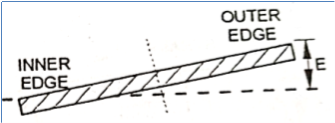
Outer edge of the pavement is raised by E.
The advantage of this method is that it can be used in areas of high rainfall and level terrain to avoid drainage problem.
Ruling Minimum Radius of Horizontal Curve
Minimum radius of horizontal curve is given by the following equation:
Rmin = 
Where,
V = minimum or ruling design speed in km/h
e = Rate of super-elevation
f = Design value of lateral friction
Ruling Minimum Radius
a) For NH & SH = 360m
b) For MDR = 230m
c) For ODR = 155m
d) For VR = 90m
2. Design of Vertical alignment:
Summit curves are vertical curves which are formed when two gradients meet such that there is no discomfort to passengers. But, the main problem in summit curves is to provide adequate sight distance.
Ideally, circular summit curves are best as the sight distance available throughout the summit curve is constant. However, practically simple parabolic curves are used because of best riding qualities, simplicity of calculation work and uniform rate of change of grade. The equation for parabolic summit curves is as follows:
y =a.x2
Where,
a = N/2L
N is the deviation angle and L is the length of the curve.
Minimum radius of parabolic curve summit curve is given by R = L/N

Calculation of Deviation Angle
Length of Summit Curves (L) for Stopping Sight Distance (SSD)
Case 1: L > SSD
L = 
Where, L = Length of Summit Curve (m)
S = SSD (m)
N = deviation angle = algebraic sum of grade
H = height of eye level of driver above road surface = 1.2m
h = height of object above pavement surface = 0.15m
Now, if H = 1.2m and h = 0.15m, then L = 
Case 2: L < SSD
L =  = 2S –
= 2S –
Length of Summit Curves (L) for Overtaking Sight Distance (OSD) and Intermediate Sight Distance (ISD)
Case 1: L >OSD or ISD
L = 
Where,
L = Length of Summit Curve (m)
S = OSD/ ISD (m)
N = deviation angle = algebraic sum of grade
H = height of eye level of driver above road surface = 1.2m
Now, if H = 1.2m, then L = 
Case 2: L <OSD or ISD
L =  = 2S –
= 2S –
Key takeaway:
- A horizontal curve acts as a transition between two tangent strips of roadway, allowing a vehicle to negotiate a turn at a gradual rate rather than a sharp cut.
- The design of the horizontal curve is dependent on the design speed for the roadway, as well as the drainage conditions and friction factor for the road.
- Summit curves are vertical curves which are formed when two gradients meet such that there is no discomfort to passengers.
1) Horizontal curves:
Horizontal alignment design involves the understanding of the design aspects such as design speed and the effect of the horizontal curve on the vehicles.
The horizontal curve design elements include the design of super elevation, extra widening at horizontal curves, design of transition curve, and set back distance.
The presence of a horizontal curve imparts centrifugal force which is reactive force acting outward on a vehicle negotiating it. The centrifugal force depends on the speed and radius of the horizontal curve and is counteracted to a certain extent by transverse friction between the tyre and pavement surface.
On a curved road, this force tends to cause the vehicle to overrun or to slide outward from the center of road curvature.
Forces acting on a Vehicle on Horizontal Curve
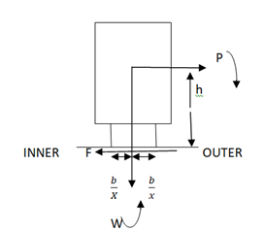
b: Distance between two wheels or total width of the wheelbase
h: height of the center of gravity of vehicle above the road surface
W: Weight of Vehicle
P: Centrifugal Force acting outwards


The vehicle overturns the w.r.t. Outer wheel due to Centrifugal Force. On the verge of overturning, the contact between the inner tyre and road will be lost.
Overturning:



 = Resistance against Overturning
= Resistance against Overturning


Lateral Skid: Can be avoided by increasing friction at curves

P=F
P =f*W



f: Coefficient of Lateral Friction = 0.15
2. Vertical curves:
Vertical curves facilitate a gradual change between two different gradients.
Vertical curves should be simple in application and result in a design that is safe and comfortable in operations, pleasing in appearance, and adequate for drainage.
Types of Vertical Curves:
1. Summit Curves
2. Valley Curves
1. Summit Curves
Summit curves or crest curves are convex upwards.
If Deflection angle N is Positive, the vertical curve is Summit Curve.
If the road surface is below the point of vertical intersection, then it is a summit curve
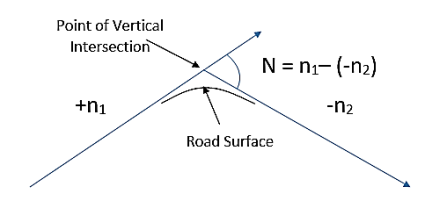
Fig.: Summit curve
Summit Curves are formed when two gradients meet as illustrated below:
- When an ascending gradient meets a descending gradient
- When a positive gradient meets a flat gradient
- When a steep ascending gradient meets a relatively mild gradient
- When a flat gradient meets a descending gradient
- When a mild descending grade meets a steeper descending gradient
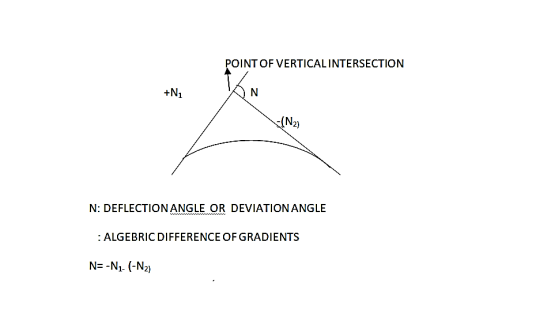
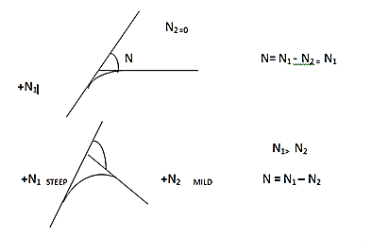

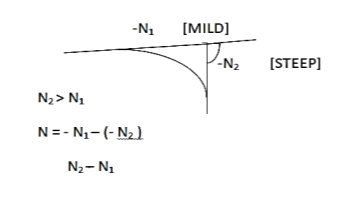
Fig.: Different Grades Curve
1) Shape of Summit Curve:
Circular summit curves are ideal as the sight distance available throughout the length of the summit curve is constant.
For small deviation angles, a simple parabola is congruent with a circular curve.
Arithmetic calculations and ordinary computation are easy for a simple parabola. So, general practice is to provide simple parabola as Summit curve
2) Design Considerations:
The stopping sight distance or absolute minimum sight distance should be provided on these curves and where overtaking is not prohibited, overtaking sight distance or intermediate sight distance should be provided as far as possible.
When a fast-moving vehicle travels along a summit curve, there is less discomfort to the passengers.
This is because the centrifugal force will be acting upwards while the vehicle negotiates a summit curve which is against the gravity and hence a part of the tyre pressure is relieved.

P: Centrifugal Force
W: Gravitational Force
3) Length of Summit Curve (IRC Approach):
The important design aspect of the summit curve is the determination of the length of the curve (L) which is parabolic.
As noted earlier, the length of the curve is guided by the sight distance consideration (S).
That is, a driver should be able to stop his vehicle safely if there is an obstruction on the other side of the road.
While deciding the length of the summit curve, two situations can arise depending on the uphill and downhill gradients
1. When the length of the curve is greater than the sight distance (L>S)
2. When the length of the curve is greater than the sight distance. ((L<S
Case 1: L>S
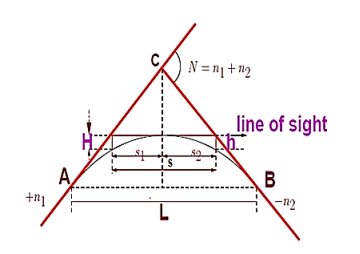
Fig.: When L> S

Where,
- L: Length of Summit Curve
- S: Sight Distance (S: SSD – when an obstruction is stationary)
- (S: OSD/ISD – when an obstruction is moving)
- N: Deviation Angle
- h1: Drivers Eye Height = 1.2m
- h2: Height of Obstruction = 0.15m
Case 2: L<S

Fig.: When L < S

When stopping sight distance (SSD) is considered the height of the driver's eye above the road surface (h1) is taken as 1.2 meters, and the height of an object above the pavement surface (h2) is taken as 0.15 meters.
If overtaking sight distance is considered, then the value of the driver's eye height (h1) and the height of the obstruction (h2) are taken equally as 1.2 meters.
2. Valley Curve:
Valley curves or sag curves are convex downwards.
If Deflection Angle N is Negative, the vertical curve is Valley Curve.
If the road surface is above the point of vertical intersection, then it is a Valley curve
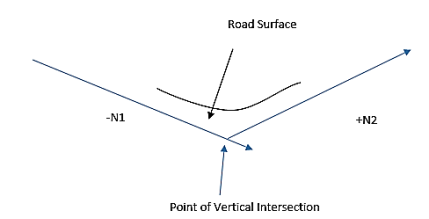
Fig.: Valley Curve
Valley Curves are formed when two gradients meet as illustrated below:
- When a descending gradient meets an ascending gradient
- When a steep descending gradient meets a relatively mild descending gradient
- When a descending/negative gradient meets a flat gradient
- When a flat gradient meets an ascending gradient
- When a mild ascending grade meets a steeper ascending gradient
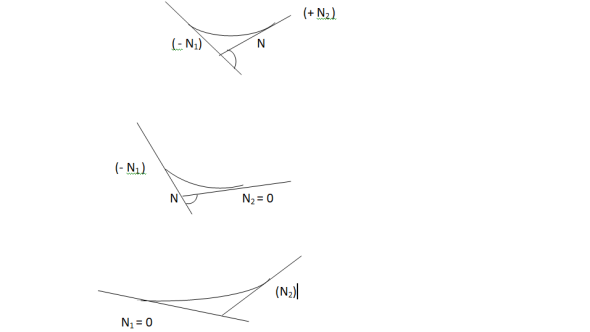
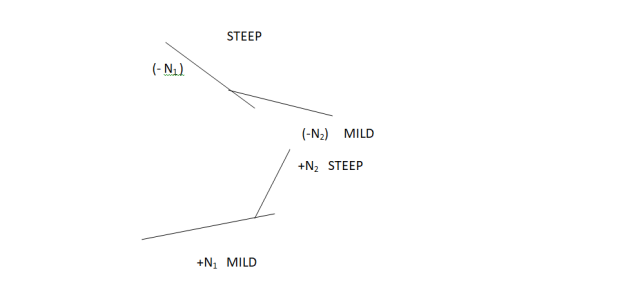
Fig.: Different Grades
1) Design Considerations:
There is no restriction to sight distance at valley curves during day time. But visibility is reduced during the night.
In the absence or inadequacy of street lights, the only source for visibility is with the help of headlights. Hence valley curves are designed taking into account headlight distance.
In valley curves, the centrifugal force will be acting downwards along with the weight of the vehicle, and hence impact to the vehicle will be more.
This will result in jerking of the vehicle and cause discomfort to the passengers.
2) Shape of Valley Curve:
For gradually introducing and increasing the centrifugal force acting downwards, the best shape that could be given for a valley curve is a transition curve.
Cubic parabola is generally preferred in vertical valley curves.
3) Length of Valley Curve (IRC Approach):
The valley curve is made fully transitional by providing two similar transition curves of equal length.
The transitional curve is set out by a cubic parabola.
The length of the Valley Transition Curve is based on two criteria
1. Comfort Criteria
2. Safety Criteria
A. Comfort or Centrifugal Acceleration Criteria

Where,
- L: Total Length of Valley Curve
- N: Deviation Angle
- C: Allowable rate of change of centrifugal acceleration = 0.61 m/s3
B. Safety or Headlight Sight Distance Criteria
While deciding the length of the valley curve for headlight distance, two situations can arise depending on the uphill and downhill gradients
1) When the length of the curve is greater than stopping sight distance (L>S)
2) When the length of the curve is greater than stopping sight distance. ((L<S)
Case 1: L>S

Where,
- L: Total Length of Valley Curve
- N: Deviation Angle
- h1: Height of Headlight = 0.75m
- α: Headlight beam angle = 1°
- S: Headlight Sight Distance, m
Case 2: L<S

Key Takeaways:
1. Overturning: - Overturning occurs on the roads when the trucks try to change directions, take sharp turns. Overturning occurs, more after, in the case of vehicles that have a greater height or whose center of gravity is much high up from the surface of roads.
2. Lateral Skid: - If a vehicle skids, it slides sideways or forwards while moving, for example, it just tipped over onto its side and skidded along the tarmac.
3. Centrifugal Force: - Centrifugal force is the apparent outward force on a mass when it is rotated. Think of a ball on the end of a string that is being twirled around, or the outward motion you feel when turning a curve in a car
4. Centrifugal Acceleration: -First, the true gravitational acceleration, of magnitude, which always points directly toward the center of the Earth. Second, the so-called centrifugal acceleration.
5. Line of sight: -Line-of-sight propagation is a characteristic of electromagnetic radiation or acoustic wave propagation which means waves travel in a direct path from the source to the destination.
References:
- Khanna S. K., Justo C.E.G, & Veeraragavan, A. “Highway Engineering”, Nem Chandand Bros., Roorkee- 247 667.
2. Khanna S. K., Justo C.E.G, & Veeraragavan A., “Highway Materials and Pavement Testing”, Nemchand and Bros., Roorkee- 247 667.
3. LR Kadiyali, Transportation Engineering, Khanna Publication.
4. L.R. Kadiyali, Transportation Engineering, Khanna Publishing House
5. Saxena, Subhash C, A Textbook of Highway and Traffic Engineering, CBS Publishers &Distributers, New Delhi
6. Kumar, R Srinivasa, “A Text book of Highway Engineering”, Universities Press, Hyderabad.
7. Kumar, R Srinivasa, “Pavement Design”, Universities Press, Hyderabad.
8. Chakraborty Partha & Das Animesh, “Principles of Transportation Engineering”, Prentice Hall (India), New Delhi,
9. IRC: 37- Latest revision, “Tentative Guidelines for the design of Flexible Pavements” Indian Roads Congress, New Delhi
10. IRC:58-2015 Guidelines for the Design of Plain Jointed Rigid Pavements for Highways (Fourth Revision) (with CD)
11. IRC:65-2017 Guidelines for Planning and Design of Roundabouts (First Revision)
12. IRC:73-1980 Geometric Design Standards for Rural (Non-Urban) Highways
13. IRC:106-1990 Guidelines for Capacity of Urban Roads in Plain Areas
14. IRC: 93-1985 Guidelines on Design and Installation of Road Traffic Signals.
15. IRC:92-2017 Guidelines for Design of Interchanges in Urban Areas (First Revision)
16. IRC: SP: 68-2005, “Guidelines for Construction of Roller Compacted Concrete Pavements”, Indian Roads Congress, New Delhi.
17. IRC: 15-2002, “Standard Specifications and Code of Practice for construction of Concrete Roads” Indian Roads Congress, New Delhi.
18. MORTH, “Specifications for Road and Bridge Works”, Ministry of Shipping, Road Transport & Highways, Published by Indian Roads Congress, New Delhi.